
Washington Union Station, known locally as Union Station, is a major train station, transportation hub, and leisure destination in Washington, D.C. Designed by Daniel Burnham and opened in 1907, it is Amtrak's headquarters, the railroad's second-busiest station, and North America's 10th-busiest railroad station. The station is the southern terminus of the Northeast Corridor, an electrified rail line extending north through major cities including Baltimore, Philadelphia, New York City, and Boston, and the busiest passenger rail line in the nation. In 2015, it served just under five million passengers.

Alexandria Union Station is a historic railroad station in Alexandria, Virginia, south of Washington, D.C. To avoid confusion with nearby Washington Union Station, the station is often referred to as simply Alexandria. Its Amtrak code is ALX.

Springfield Union Station is a train and bus station in the Metro Center area of Springfield, Massachusetts. Constructed in 1926, Springfield Union Station is the fifth-busiest Amtrak station in the Commonwealth, and the busiest outside of Greater Boston.
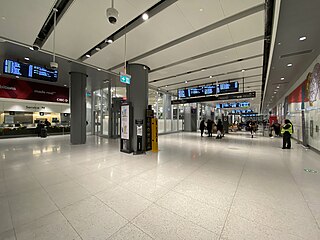
The Union Station Bus Terminal is the central intercity bus terminal in Toronto, Ontario, Canada. It is located in Downtown Toronto on the second floor of the south tower of CIBC Square, on the northeast corner of Bay Street and Lake Shore Boulevard. The terminal currently serves GO Transit regional buses as well as Coach Canada, Greyhound Lines and Ontario Northland long-distance bus services, among others. Owned by the provincial Crown agency Metrolinx, the terminal is connected by pedestrian walkways to the adjacent Union Station, Canada's busiest transportation hub.

The Charlottesville Union Station, located in Charlottesville, Virginia, United States, is served by Amtrak's Cardinal,Crescent, and daily Northeast Regional passenger trains. It is Amtrak's third-busiest station in Virginia, aside from its all-auto Auto Train station in Lorton. The station is situated in the northeast quadrant of the junction between two railway lines. The Cardinal uses the east–west line, owned by the state of Virginia, and formerly by CSX Transportation, and operated by the Buckingham Branch Railroad, while other services use the north–south line owned and operated by Norfolk Southern Railway. The station is within walking distance of the University of Virginia, which is the major employer in the area.

Transportation in the Commonwealth of Virginia is by land, sea and air. Virginia's extensive network of highways and railroads were developed and built over a period almost 400 years, beginning almost immediately after the founding of Jamestown in 1607, and often incorporating old established trails of the Native Americans.

New Orleans Union Passenger Terminal (NOUPT) is an intermodal facility in New Orleans, Louisiana, US. Located at 1001 Loyola Avenue, it is served by Amtrak, Greyhound Lines, Megabus, and NORTA with direct connections to the Rampart–St. Claude Streetcar Line.
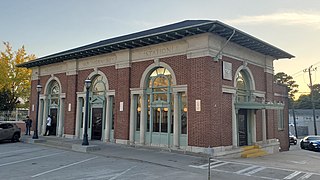
Atlanta Peachtree Station is a train station in Atlanta, Georgia. It is currently a service stop for Amtrak's Crescent passenger train. The street address is 1688 Peachtree Road, Northwest, in the Brookwood section of town between Buckhead and Midtown.

Martin Luther King Jr. Plaza is the main passenger rail and intercity bus station of Toledo, Ohio.

Sacramento Valley Station is an Amtrak railway station in the city of Sacramento, California, at 401 I Street on the corner of Fifth Street, built in 1926 on the site of China Slough. It is the thirteenth busiest Amtrak station in the country, and the second busiest in the Western United States. It is served by four different Amtrak train routes and connecting Amtrak Thruway motorcoaches. It is also the western terminus for the Gold Line of the Sacramento RT Light Rail system and the Route 30 bus serving California State University, Sacramento.

Birmingham station is a train station in Birmingham, Alabama. It is a service stop for Amtrak's Crescent, which provides daily service between New York City, Atlanta, and New Orleans. The current station is located on the site of another station originally built by the Louisville and Nashville Railroad in 1960, although Amtrak did not use the building itself, which was torn down in the 2000s.

Charlotte station is an Amtrak station located at 1914 North Tryon Street, about 1.5 miles (2.4 km) to the northeast of Uptown Charlotte. Owned by Norfolk Southern, it is located near that railroad's yard outside Uptown.

J. Douglas Galyon Depot, also known as Greensboro station, is an intermodal transit facility in Greensboro, North Carolina. Located at 236 East Washington Street in downtown Greensboro, it serves Amtrak passenger rail and is the city's main hub for local and intercity buses.
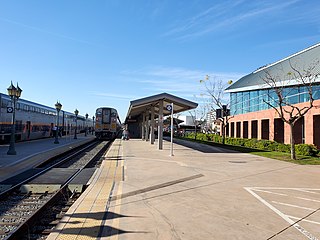
Bakersfield station is an intermodal facility in Bakersfield, California. It is the southern terminus of Amtrak California's San Joaquins route, with Amtrak Thruway buses continuing to Amtrak stations and bus stops throughout Southern California and Nevada. The station opened with a celebration on July 4, 2000. It contains an 8,300-square-foot (770 m2) train station with two platforms and three tracks, as well as a 17-bay bus station.

Milwaukee Intermodal Station is an intercity bus and train station in downtown Milwaukee, Wisconsin. Amtrak service at Milwaukee includes the daily Empire Builder, the daily Borealis, and the six daily Hiawatha Service round trips. It is Amtrak's 18th-busiest station nationwide, and the second-busiest in the Midwest, behind only Chicago Union Station. The station is served by bus companies Coach USA - Wisconsin Coach Lines, Greyhound Lines, Jefferson Lines, Indian Trails, Lamers, Badger Bus, Tornado Bus Company, and Megabus. It is also the western terminus of the M-Line service of The Hop streetcar.
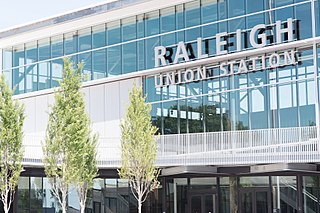
Raleigh Union Station is an intermodal transit station in Raleigh, North Carolina, United States. Train service began the morning of July 10, 2018. Its main building serves as an Amtrak train station, while a future adjacent building will serve as the bus terminus for GoTriangle. The station is located at the Boylan Wye, a railroad junction used by CSX and Norfolk Southern, and adjacent to the Depot Historic District in downtown Raleigh.
Located in the southeastern corner of the state, Norfolk is economically and culturally important to Virginia. A variety of transportation modes have developed around the city's importance and somewhat unusual geography.

Charlotte Gateway Station is a future intermodal transit station in Charlotte, North Carolina, United States. Currently operating as a streetcar stop for the CityLynx Gold Line, with an adjoining bus station for Greyhound Lines intercity buses, it is the centerpiece of the overall 19-acre (7.7 ha) Station District, and it will serve Charlotte Area Transit System (CATS) bus lines, the Lynx Silver Line light rail, Amtrak intercity trains. The district will also include parking facilities, mixed-use development and an elevated greenway. Estimated at a cost of $800.1 million for full implementation of all public and private components, the project will be built in three phases, with Amtrak service tentatively scheduled to start in 2026–2027.

Amtrak Virginia is the collective name for Virginia's state-supported Amtrak train service, all of which falls under the Northeast Regional brand. Amtrak Virginia trains run between Washington, D.C., and one of four southern termini: Richmond, Newport News, Norfolk, or Roanoke. Trains generally continue north from D.C. along the Northeast Corridor, providing one-seat rides from Virginia to Baltimore, Philadelphia, New York City, and Boston.
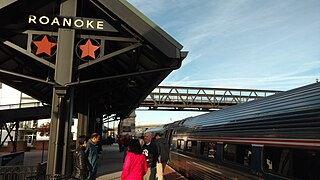
Roanoke station is a train station in Roanoke, Virginia, the current southern terminus of Amtrak's Northeast Regional line. Built in 2017, it follows several other Roanoke passenger stations that operated from the 1850s to 1979. The unstaffed station consists of a single high-level platform with no station building or waiting room available for passengers. All tickets must be purchased in advance; there is no Quik-Trak kiosk at the station.






















